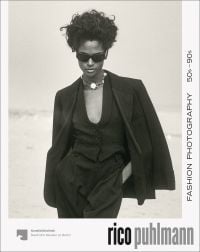
Rico Puhlmann: Fashion Photography 50s–90s – Museum of Photography, Germany
27 Jun — 15 Feb 2026
Rico Puhlmann
Fashion Photography 50s–90s
June 27, 2025 to February 15, 2026
Museum of Photography
Rico Puhlmann (1934-1996) was one of the most internationally renowned fashion photographers and shaped the fashion landscape of his time over the last four decades of the 20th century. This exhibition celebrates Puhlmann’s career, particularly his drawings and photographs for fashion magazines from the 1950s to the 1990s. It examines various aspects of fashion, photography, press, and cultural history.
The exhibition offers a comprehensive insight into the drawing and photography of Rico Puhlmann, who worked for over 40 years, first as an illustrator and then as a fashion photographer, for major magazines such as “Brigitte,” “petra,” “Constanze,” and internationally, “Vogue,” “Harper’s Bazaar,” “Glamour,” and “GQ.” The most sought-after models of their time posed before his camera: Gloria Friedrich and Gitta Schilling, Cheryl Tiegs and Jerry Hall, Cindy Crawford and Naomi Campbell. His photographs appeared on numerous magazine covers, and his glossy photo spreads filled several consecutive double-page spreads.
The majority of the exhibits come from Rico Puhlmann’s extensive estate, which is managed by his brother Klaus Puhlmann and his wife Anne Puhlmann and generously made available for the exhibition.
Post-war Berlin chic
Puhlmann began his career as a fashion illustrator in his native Berlin, where “Berlin chic” reached a new peak after the Second World War. He was repeatedly commissioned to initially draw and then increasingly photograph the designs of fashion houses – for magazines and company publications. He shaped the image of this West Berlin fashion just as much as his colleagues FC Gundlach, Regi Relang, and Helmut Newton. Their photographs are visual testaments to an unwritten dress code around 1960.
Changing fashion and technical developments
Op and Pop Art, a passion for space travel, the London Swinging Sixties, and the adaptation of dress shapes and fabric patterns from diverse cultures changed fashion in the 1960s, as well as the perception of fashion. Editors sent photographers to increasingly distant locations to shoot fashion. Technical developments such as flash technology, the emergence of color film, Polaroid, and the more flexible 35mm format gradually expanded the scope of photographic creativity.
American look of the 1970s and new freedom
Due to the declining economy of Berlin’s upscale fashion industry and the resulting decline in the importance of fashion in Berlin, Puhlmann reoriented himself and moved to New York in 1970. In his new hometown, he received his first photography assignments from the magazines “Glamour” and “Harper’s Bazaar.” At the same time, he shot fashion films for the “Modejournal” produced by Sender Freies Berlin (SFB), thus becoming one of the pioneers of the “American Look” in Europe.
By the mid-1970s, Rico Puhlmann had established himself as a fashion photographer in New York. His photographs speak of a new freedom. No longer are the stilted poses, the gentlemanly companion, the cultivated and manicured urban space, but rather naturalness, movement, spontaneity, informality, and interpersonal closeness that define his images. In the two models Cheryl Tiegs and Patti Hansen, Rico Puhlmann found the perfect counterparts to convey this new attitude to life.
Changing image of women and men
Until the early 1990s, Rico Puhlmann worked continuously for Harper’s Bazaar, contributing with his work to the changing image of women, who were increasingly presenting themselves with greater self-confidence. Around 1980, he received exclusive commissions for various issues of “Fashions of the Times,” the fashion supplement to the New York Times. For the men’s magazine GQ in the early 1980s, he used subtle, insightful imagery to describe men’s new self-image in terms of fashion, styling, and grooming.
Puhlmann’s work in a media world organized by division of labor
Meanwhile, increasingly large editorial teams collaborated on fashion photography. In addition to Rico Puhlmann, fashion and accessory editors, art directors, makeup artists, and hairdressers were involved in image design. As recently as the 1960s, Puhlmann, together with the respective editors, had personally selected the designs at the fashion shows, as well as the locations and models. He checked the styling and makeup after the models had applied their own makeup and dressed themselves. He directed poses and gestures and selected props and accessories.
Future plans and abrupt end
Puhlmann died in a plane crash in 1996. A book about his work was already being planned. A return to Berlin with a teaching position at the local University of the Arts was also under discussion, and his first digital camera had already been purchased. Even after more than 40 years of creativity, Rico Puhlmann had plans.
Curatorial Team
The exhibition is curated by Dr. Britta Bommert, Head of the Fashion Image Collection, Art Library – National Museums in Berlin, and co-curator Hans-Michael Koetzle, Munich, in close collaboration with the Rico Puhlmann Archive (Anne and Klaus Puhlmann), Berlin.
Catalogue
A comprehensive catalogue with contributions by Britta Bommert, Gerlind Hector, Hans-Michael Koetzle, Adelheid Rasche, Marie Arleth Skov and Christine Waidenschlager will be published by Kettler Verlag, Dortmund, to accompany the exhibition.
Please log-in or create an account to see your recent items.